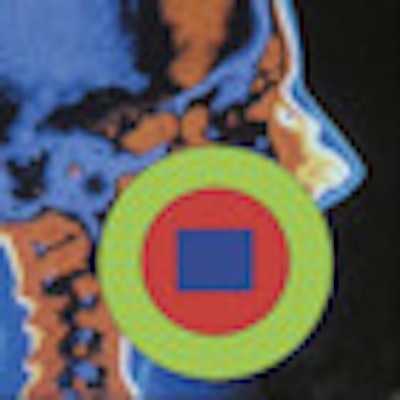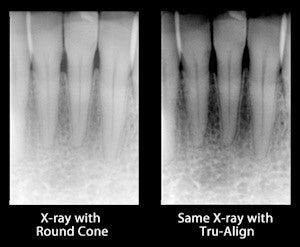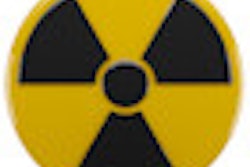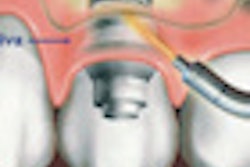
A unique rectangular collimator design being reintroduced to the dental market this spring could help address growing concerns about exposure to unnecessary radiation.
The Tru-Align collimator, first introduced in 2008, has undergone a renaissance of sorts, according to its inventor, Michael R. Razzano, DDS, chairman and CEO of Interactive Diagnostic Imaging (IDI), the company that manufactures the device. The result is a more affordable product that overcomes the inherent challenges of other collimators.
"There are three types of collimators," Dr. Razzano said. "One is round, which is 98% of the market. The second is rectangular, which has limited application because it is hard to use. The third is the Tru-Align, which uses a rectangular collimator but takes it to another level."
“Tru-Align is like a rifle with a special alignment system.”
— Michael R. Razzano, DDS, chairman
and CEO, Interactive Diagnostic
Imaging
Although rectangular collimators are generally acknowledged as a better alternative to round collimators, they can be challenging to use, he said. Inherent issues such as cone cutting can affect image quality, which in turn can mean more retakes.
And although a round cone can overcome the cone-cutting problem because of its larger beam area, it also exposes patients to more than four times the radiation compared with rectangular collimators, according to Dr. Razzano.
"A round collimator can be viewed much like a shotgun," Dr. Razzano said. "It shoots out the radiation a good two-thirds as big as the film or phosphor, so there is a lot of excess radiation. A rectangular collimator is like a rifle, and Tru-Align is like a rifle with a special alignment system."
How it works
 The Tru-Align retrofits over most existing round cones and can be used with film, digital sensors, or phosphor plates. All images courtesy of Interactive Diagnostic Imaging.
The Tru-Align retrofits over most existing round cones and can be used with film, digital sensors, or phosphor plates. All images courtesy of Interactive Diagnostic Imaging.
The Tru-Align retrofits over most existing round cones and can be used with film, digital sensors, or phosphor plates, as well as most standard film and sensor holders, he explained. Attached to the end of the rectangular cone is a magnetized ring that locks on to the holder when it is aligned properly. When the beam is aligned with the acquisition device, the unit beeps and/or a light flashes, indicating optimum alignment.
The end result is improved image quality and less exposure to radiation, according to Dr. Razzano.
"The Tru-Align guarantees precise alignment and positioning," he said. "It ensures alignment of the long axis of the x-ray beam perpendicular to the center of the acquisition device, whether film, sensor, or phosphor plate. This is what ensures optimal diagnostic image quality."
But image quality isn't the primary reason for using rectangular collimation, stated John B. Ludlow, DDS, program director of oral and maxillofacial radiology at the University of North Carolina School of Dentistry, in an email to DrBicuspid.com.
"My position on rectangular collimation is that any device is better than the alternative of a round cone," he said. "But because receptor placement is dictated by patient anatomy and controlled by the operator, collimation makes little difference in the result."
Patient dose is a different issue, Dr. Ludlow added.
"While rectangular collimation physically reduces the area of exposure by approximately 55% (calculated as the difference between an appropriately sized circle round cone and the rectangular opening in the collimator), effective dose to the patient is reduced to an even greater extent because peripheral radiosensitive tissues such as parotid salivary glands and the thyroid gland receive less exposure," he said.
 Tru-Align improves image quality by ensuring proper alignment, according to its developers. Left, an image taken using a round collimator; right, the same image taken with Tru-Align.
Tru-Align improves image quality by ensuring proper alignment, according to its developers. Left, an image taken using a round collimator; right, the same image taken with Tru-Align.
According to Dr. Razzano, rectangular collimators significantly reduce excess scatter radiation. On top of that, Tru-Align's alignment system helps minimize the number of retakes, further reducing radiation exposure, he said.
However, "the literature and my own experience through many years of instructing students in the use of rectangular collimation has shown that the difference in retakes resulting from the use of rectangular collimation is very small," Dr. Ludlow said. "The principal reasons for retakes involve improper positioning and/or angulation of the receptor. These errors result in missed areas of interest and/or closed contacts."
And in a study conducted at the University of Texas Dental Branch at Houston, the Tru-Align was found to be more user-friendly but also more prone to cone-cut errors than two other types of rectangular collimators (Oral Surgery, Oral Medicine, Oral Pathology, Oral Radiology, and Endodontology, July 2009, Vol. 108:1, pp. e22-e28).
The newly redesigned Tru-Align overcomes these issues, according to Dr. Razzano.
"When we introduced this product a couple of years ago, we found out that it needed some revisions," he said. "So we pulled it off the market and significantly improved the product and the application."
The price is more reasonable now too, he added -- $795, compared with the original $1,295.
"I have not worked with the Tru-Align system but have read a number of favorable reviews of the device," Dr. Ludlow said.
The new Tru-Align will be officially reintroduced to the dental market at next month's California Dental Association meeting in Anaheim, where IDI will have a booth, Dr. Razzano said.



















